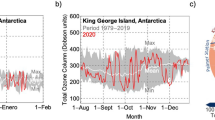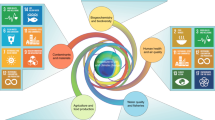Abstract
Many recent studies1–3 indicate that releases of chlorofluoro-carbons (CFCs)—mainly chlorofluoromethanes (CFMs)—into the atmosphere deplete the stratospheric ozone layer. Potentially dangerous consequences of these ozone depletions, such as increases in skin cancer, are expected due to a subsequent increase in biologically damaging solar UV radiation reaching the ground. The biological effectiveness of this radiation amplification can be quantified by a radiation amplification factor (RAF) for which a value of 2 has been previously assumed: RAF = 2 means, for example, that a 1% ozone depletion will result in a 2% increase in damaging UV dose at ground level. Using accurate radiative transfer calculations together with a detailed modern data base, we calculate here the RAFs for erythemally and DNA-weighted UV–B dose assuming ozone depletions as resulting from a two-dimensional model, as well as a global ozone depletion of 10%. The amplification factor as a function of latitude and season is found to be between 1.9 and 2.2 for erythema and between 2.5 and 2.8 for DNA. This is a smaller range variation than previously claimed.
This is a preview of subscription content, access via your institution
Access options
Subscribe to this journal
Receive 51 print issues and online access
$199.00 per year
only $3.90 per issue
Buy this article
- Purchase on Springer Link
- Instant access to full article PDF
Prices may be subject to local taxes which are calculated during checkout
Similar content being viewed by others
References
Molina, M. J. & Rowland, F. S. Nature 249, 810–812 (1974).
Protection against Depletion of Stratospheric Ozone by Chlorofluorocarbons (National Academy of Sciences, Washington DC, 1979).
Stratospheric Ozone Depletion by Halocarbons: Chemistry and Transport (National Academy of Sciences, Washington DC, 1979).
Wine, P. H. et al. J. geophys Res. 86, 1105–1112 (1981).
Pyle, A. J. Nature 271, 42–43 (1978).
Pyle, J. A. & Derwent, R. G. Nature 286, 373–375 (1980).
Green, A. E. S. & Mo, T. Impacts of Climatic Change on the Biosphere, Chap. 2, Part 1, (US Dept of Transportation, CIAP Monogr. 5 Rep DOT-TST-75-55, 1975).
Gerstl, S. A. W. Application of the Adjoint Method in Atmospheric Radiative Transfer Calculations Los Alamos National Laboratory Report LA-UR-80-17; Application of Modem Neutron Transport Methods to Atmospheric Radiative Transfer, Int. Rad. Symp., Fort Collins (1980).
McClatchey, R. A., Fenn, R. W., Selby, J. E. A., Volz, F. E. & Garing, J. S. Optical Properties of the Atmosphere 3rd edn (AFCRL-72-0497, 1972).
Kneizys, F. X. et al. Atmospheric Transmittance/Radiance: Computer Code LOWTRAN 5 (AFGL-TR-80-0067, 1980).
Shettle, E. P. & Green, A. E. S. Appl. Opt. 13, 1567–1581 (1974).
Shettle, E. P. & Fenn, R. W. Models for the Aerosols of the Lower Atmosphere (AFGL-TR-79-0214, 1979).
Coblentz, W. W. & Stair, R. U.S. Bur. Standard. J. Res. 12, 13–14 (1934).
Green, A. E. S. & Miller, J. H. in Impacts of Climatic Change on the Biosphere, 2–60 (US Dept of Transportation CIAP Monogr. 5, Rep. DOT-TST-75-55, 1975).
Setlow, R. B. Proc. natn. Acad. Sci. U.S.A. 71, 3363–3366 (1974).
Zardecki, A. & Gerstl, S. A. W. Calculations of Solar Irradiances in Clear and Polluted Atmospheres and Potential Effects on Plant Life (Los Alamos National Laboratory Rep. LA-9010-MS, 1981).
Author information
Authors and Affiliations
Rights and permissions
About this article
Cite this article
Gerstl, S., Zardecki, A. & Wiser, H. Biologically damaging radiation amplified by ozone depletions. Nature 294, 352–354 (1981). https://doi.org/10.1038/294352a0
Received:
Accepted:
Issue Date:
DOI: https://doi.org/10.1038/294352a0
This article is cited by
-
Relationship between ozone and biologically relevant UV at 4 NDACC sites
Photochemical & Photobiological Sciences (2022)
-
Chlorofluorocarbon interaction with DPPC vesicles: An ESR investigation
Radiation and Environmental Biophysics (1991)
-
UV-B dose/dose-rate responses of seasonally abundant copepods of Puget Sound
Oecologia (1988)
-
Effects of aerosols on photosynthesis
Nature (1982)
Comments
By submitting a comment you agree to abide by our Terms and Community Guidelines. If you find something abusive or that does not comply with our terms or guidelines please flag it as inappropriate.



